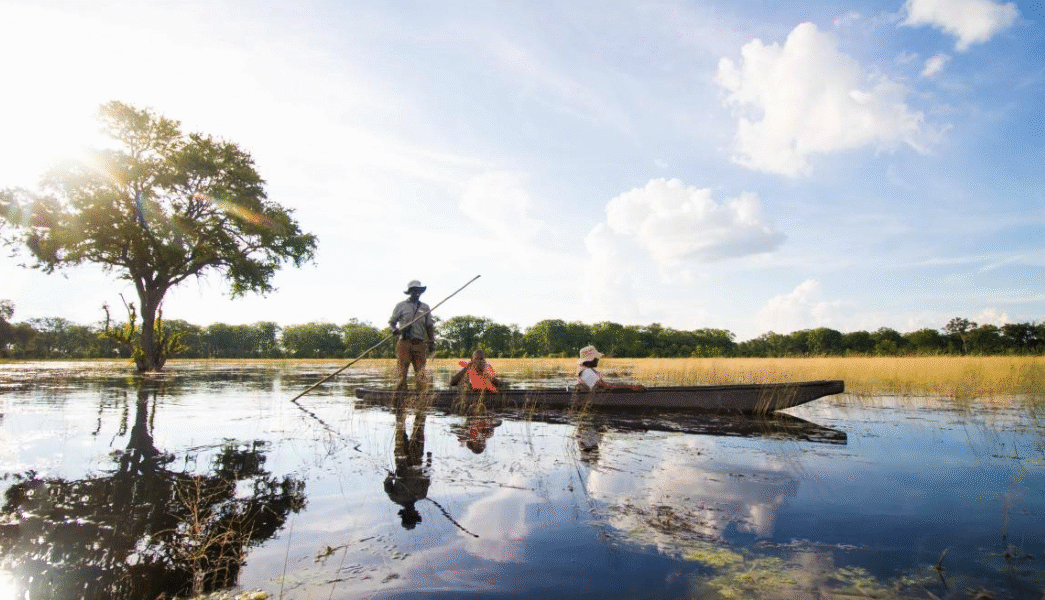As Botswana charts a new course for tourism, the Blue Route project promises to return value and ownership to local hands — shifting the model from extraction to inclusion.
For decades, Botswana’s tourism model has been hailed as Africa’s gold standard — high value, low volume, and light on the land.
Its pristine parks and private lodges have long symbolised conservation success. Yet as major players like Wilderness Safaris
quietly shifted their headquarters offshore, questions began to surface: who truly benefits from Botswana’s most celebrated industry?
FOREIGN CONTROL, LOCAL COSTS
Increasingly, evidence points to an economic model that extracts wealth from local communities while enriching a foreign elite.
Research from the University of Manchester in 2025 revealed that 82 percent of Okavango Delta accommodation is foreign-owned,
and barely one in ten tourism firms pays full tax in Botswana. This means the bulk of tourism income — from safaris to luxury stays —
leaks abroad, bypassing citizens and the national treasury.
Economists call this value leakage — where profits are exported while jobs and infrastructure costs stay local. The problem,
as analysts argue, is not tourism itself but its ownership structure. Lodges may advertise community partnerships, yet profits
still flow outward while Batswana foot the environmental and social bill. The result is a paradox: citizens pay for a tourism industry
they don’t control.
A NEW FRONTIER FOR LOCALISATION
Botswana’s next phase of tourism must be defined by localisation, not liberalisation. That means moving from foreign dominance
to citizen empowerment. One promising innovation is the Botswana Blue Route (BBR), a national 4,000-kilometre circuit that connects
fifteen towns, hundreds of villages, and over a hundred tourism sites — from Khama Rhino Sanctuary and Makgadikgadi Pans
to Chobe and Ghanzi.
Originally conceived in 2014, the Blue Route embodies the values of peace, water, and unity — Botswana’s national colours.
But beyond symbolism, it offers a practical roadmap to diversify tourism beyond the Okavango and redistribute opportunities
to rural communities. Once complete, the route will close two key gaps — Kachikau–Mohembo and Hukuntsi–Tsabong — linking
every region into a seamless tourism loop.
INCLUSIVE TOURISM BY DESIGN
The Blue Route is not just infrastructure; it is a strategy for inclusive growth. Under NDP12, it aligns with the goal of building
a deep, citizen-led economy. It aims to expand community-based enterprises — from craft markets and homestays to small cafés
and agro-tourism ventures — all connected through digital integration via a Blue Route mobile app showcasing local businesses,
eco-certified lodges, and rural experiences.
If managed well, this approach could recapture billions in leaked value. Studies show that over half of Botswana’s tourism
spending — around BWP 7.9 billion annually — exits the country through imports and expatriated profits. If even ten percent
were retained locally, it could generate over BWP 1.3 billion in new income each year, directly supporting small enterprises,
farmers, and artisans in rural districts.
FROM SAFARIS TO COMMUNITIES
For decades, Botswana’s tourism has been synonymous with elite safari concessions. But the future lies in spreading opportunity,
not exclusivity. NDP12 marks this shift clearly: while maintaining the conservation ethos, it encourages diversification through
heritage tourism, agri-tourism, and citizen equity participation via a proposed Tourism Equity Fund.
This policy evolution doesn’t discard the high-value model — it modernises it. The aim is not mass tourism, but balanced tourism,
where community lodges and small guesthouses coexist with luxury operators under fairer terms.
RURAL DIVIDENDS AND JOB CREATION
The Blue Route traverses Botswana’s so-called poverty belts — areas rich in culture but low in formal employment. Here,
tourism can ignite local economies. Guesthouses in Palapye, cycling trails in Hukuntsi, and cafés in Serowe can all become
micro-industries generating sustainable livelihoods for women and youth. NDP12 projects tourism employment to grow from
50,000 to nearly 65,000 jobs by 2030, provided ownership and procurement are localised.
Such diversification also strengthens other sectors. By sourcing food from local farmers and materials from domestic suppliers,
tourism becomes a multiplier for agriculture and manufacturing — the backbone of a diversified economy.
A TOURISM MODEL FOR BATSWANA
The question now is whether industry bodies like HATAB will back this localisation agenda. While HATAB champions growth
and stakeholder dialogue, it has yet to take a firm stance on citizen ownership or the repatriation of profits. Its members
include powerful foreign players, leaving many to wonder whether it serves national interests or entrenches the status quo.
To truly serve Batswana, the tourism industry must shift from enclave to ecosystem — one where profits circulate within the country,
and local entrepreneurs are at the centre of value creation. As one analyst puts it, “Botswana’s next tourism frontier is not another
five-star lodge in a delta concession, but a five-star experience in a local village.”
CONCLUSION: THE BLUE ROUTE AS A SYMBOL
The Blue Route symbolises a turning point. It can transform tourism from a story of exclusion to one of participation.
It can reconnect urban and rural economies, empower small businesses, and democratise the nation’s most iconic industry.
If Botswana succeeds in localising tourism ownership, it will not only preserve its natural heritage but ensure that every
Motswana has a genuine stake in its beauty and prosperity.
“Botswana’s next tourism frontier is not another five-star lodge, but a five-star experience in a local village.”
“Localisation, not liberalisation, is the new imperative.”

